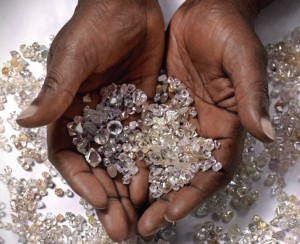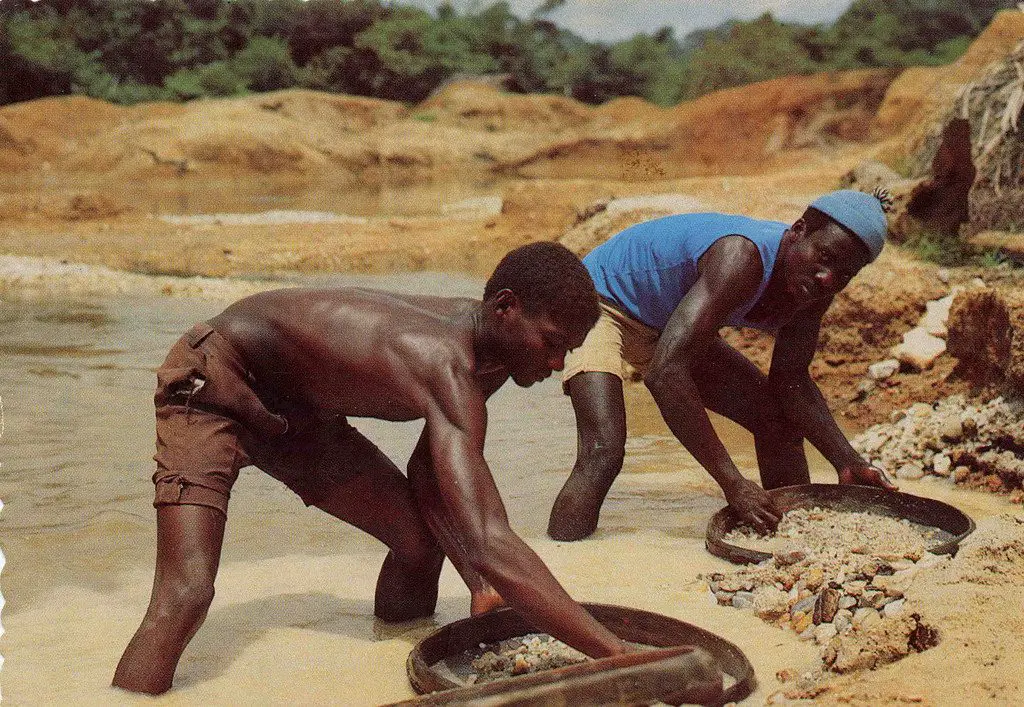With the holidays approaching soon, many shoppers will be purchasing diamonds as gift for their loved ones. While these sparkling stones are the ultimate romantic gesture, what goes on behind the scenes with the Kimberly Process and blood diamonds can be surprising.
Diamonds for Sale: The Kimberly Process
 Most consumers are not aware of the unfortunate consequences of the diamond trade, such as violent warlord conflicts, civil wars and severe human rights abuses. Yet the problem rages on, even today. The Kimberly Process Certification Scheme (KPCS) was set up in 2003 to create a certification process for diamonds trading in war-torn Africa. So far 75 countries have joined in this essentially self-regulated certification scheme. In theory, the process should follow these guidelines:
Most consumers are not aware of the unfortunate consequences of the diamond trade, such as violent warlord conflicts, civil wars and severe human rights abuses. Yet the problem rages on, even today. The Kimberly Process Certification Scheme (KPCS) was set up in 2003 to create a certification process for diamonds trading in war-torn Africa. So far 75 countries have joined in this essentially self-regulated certification scheme. In theory, the process should follow these guidelines:
1. Mined diamonds are placed in secure containers and shipped internationally.
2. Each diamond has a unique serial identification number on corresponding forgery-proofed certification.
3. To ensure that illegal, conflict diamonds are not secretly added to the shipment, the certificate documents the precise origin and destination for each diamond. Unfortunately, this is primarily a self-regulating process in which many of the countries the diamonds pass through are full of corruption and loopholes.
How Many Blood Diamonds for Sale in Zimbabwe?
 The controversial Marange diamond mines in Eastern Zimbabwe have netted 4.5 million stones at a value of $2 billion dollars. Troops there have killed and raped thousands of people and small children are forced to work in the mines. The diamonds sold from this mine in particular fund the criminals and the ruling individuals in Zimbabwe’s upper class. The government has consistently failed to meet the standards required by the KP and other conditions outlined in the diamond trade.
The controversial Marange diamond mines in Eastern Zimbabwe have netted 4.5 million stones at a value of $2 billion dollars. Troops there have killed and raped thousands of people and small children are forced to work in the mines. The diamonds sold from this mine in particular fund the criminals and the ruling individuals in Zimbabwe’s upper class. The government has consistently failed to meet the standards required by the KP and other conditions outlined in the diamond trade.
Why the Kimberly Process May Not Help Diamonds for Sale in the U.S.
‘Blood diamonds’ regime ‘a sham,’ says Canadian Expert
Because of these issues, this highly touted KP has been reduced to a “sham”, according to a Canadian diamond trade expert who helped create the KPCS from the beginning.
“The thing’s got teeth but they won’t bite,” Ian Smillie said Thursday. “In fact what we’ve got is a sham agreement, a regulatory system that refuses to regulate, a regulatory system that’s supposed to end conflict diamonds but in fact is endorsing conflict.”
Smillie is referring to the recent sale of $2 billion dollars of diamonds from the highly controversial Zimbabwe diamond mines. The KP meeting of diamond trade experts determined that they would allow for this sale to occur. The horrific nature of the human rights abuses and smuggling has caused many to wonder why the KP would give Zimbabwe such allowances for diamond trade under these circumstances.
Smillie is asking for reforms to the certification system so that it can “bite down on the crooks when they come into vision.”
How Does the Corruption Affect Diamonds for Sale in Jewelry Stores?
![]() The problems associated with diamond mining are significant, which then places jewelery stores in a difficult situation. They must ensure that all of their loose diamonds or others set in engagement, wedding and anniversary rings are not blood or conflict diamonds. However, as noted previously, it is not always easy to guarantee the customer is not being sold a blood diamond. In fact, according to experts in the KP, it can prove to be extremely difficult.
The problems associated with diamond mining are significant, which then places jewelery stores in a difficult situation. They must ensure that all of their loose diamonds or others set in engagement, wedding and anniversary rings are not blood or conflict diamonds. However, as noted previously, it is not always easy to guarantee the customer is not being sold a blood diamond. In fact, according to experts in the KP, it can prove to be extremely difficult.
There may only be a few ways to ensure that the diamonds consumers purchase are not blood or conflict diamonds. Here are a few tips that may help before buying diamonds:
- Purchase stones mined in reputable countries, particularly a 100% conflict-free country like Canada. Options include Brilliant Earth, Canadian Diamonds, Canadia and Polar Bear Diamonds.
- Do your research. Find out where companies obtain their diamonds and see if those countries are part of the conflict (for example Sierra Leone, Zimbabwe, Venezuela, to name a few). Some countries are better than others, even if part of the Kimberly Process.
- Buy lab diamonds, man-made diamonds, diamond simulants or synthetic diamonds. These are guaranteed to be conflict free and are usually substantially lower in price.
Continue reading for more information:
http://www.ctv.ca/CTVNews/World/20111103/blood-diamonds-sham-111103/#ixzz1eey2CxuW







